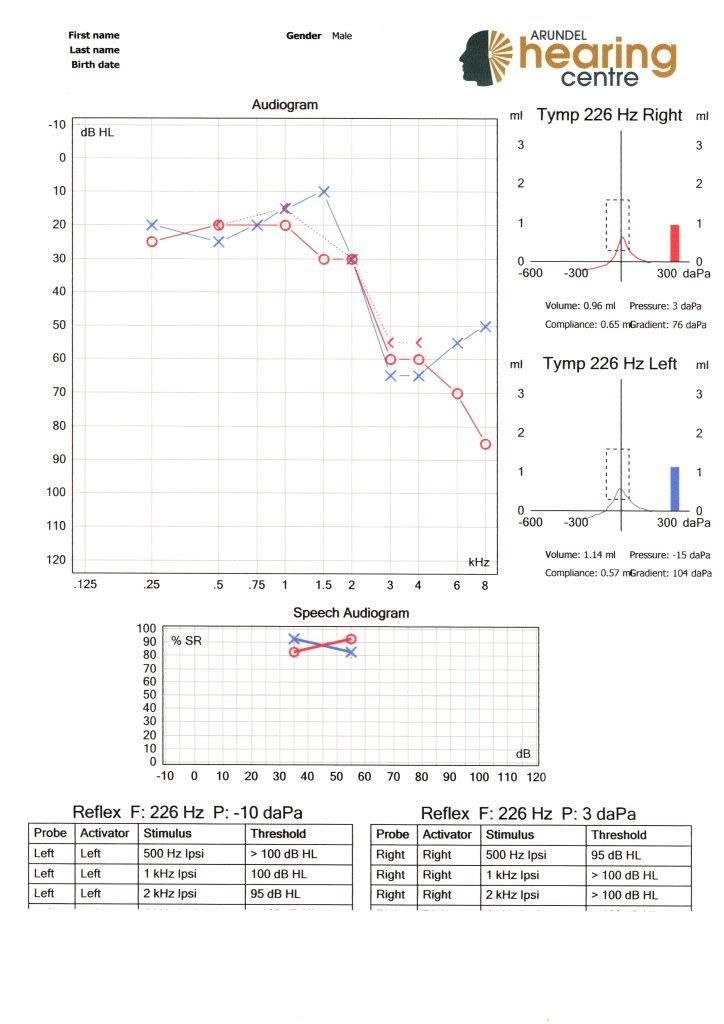



HEARING AIDS 101:
It’s important that you understand where we are trying to go with hearing aids and hearing rehabilitation so let’s assume you have just been for a hearing test and the results are those shown above.
This is called an audiogram. The numbers across the bottom are the frequencies audible to a healthy human ear. As you look at the screen, the numbers to the right are the higher frequencies and those to the left are the deeper, base tones.
Down the side is a measurement of the strength of the signal in decibels – really loud down at the bottom, really soft at the top.
There are 2 lines on the audiogram; a red one with circles and a blue one with crosses. The red is your right ear and the blue is your left ear.
Normal hearing would see both these lines somewhere above 20dB on this graph so you can see this audiogram indicates a bilateral hearing loss ranging from mild to severe in the higher frequencies.
With hearing devices, we are attempting to push all these higher frequency thresholds back above 20dB to recreate 2 nice flat lines that more accurately reflect what your cochlear did when it worked as it should.
This is where you need to understand the difference between hearing aids and glasses.
Do you remember when you finally accepted that you couldn’t see as well as you once did, and you went to the Optometrist where he asked you to read ‘that chart on the wall down there’. Your response was probably ‘what chart, I can’t see it?’
In any event, some glasses were made and when you left the clinic, immediately you could read the number plates of the cars at the other end of the street.
So, glasses are a ‘quick fix’; put them on and you can see, take them off and you can’t.
Hearing Aids are nothing like this. Essentially, they are the primary asset we use in the attempted reprogramming/rehabilitation of the auditory cortex of your brain.
Looking at our audiogram, if you accept that we are trying to recreate 2 nice flat lines above 20dB, you can understand that, when we fit the hearing aids and turn them on, we liven up all these frequencies that have been doing very little for a long time. There is a great flush of new electronic information that hits the brain and it says ‘what tha hell is all this’? It hasn’t heard all this information for a long time, and it has to reprogram itself to give you a different interpretation of what’s going on around us.
That reprogramming/rehabilitation process doesn’t happen straight away like the glasses – put ‘em on you see, take ‘em off and you can’t.
Hearing rehabilitation can take up to 16 weeks for most of this reprogramming to happen. The big part of it happens pretty quickly but it’s a plateauing effect that tapers off over time.
The degree of success or otherwise for this reprogramming job is determined not just by the caliber of the instruments we are using, nor by how well we as clinicians set them up, but equally as important at both those things put together, it’s determined by how consistent we keep that string of information relayed to the brain. The more consistent we keep that flow of information, the more successful the final result.
So, the golden rule for any hearing aids of any sort, irrespective of their cost, is that they should be worn ‘while ever you are awake’.
Common sense prevails of course, and you take them off when you are doing something noisy, (put your headphones on, do the noisy thing and then put your hearing aids back on). If you have a swim, a wash or a shower, they don’t like that much water so take them off. If you want to lie down after lunch and have a camp, take them off – they’re uncomfortable things to sleep in.
But, even if you’re sitting on the back verandah, having a cup of tea, reading the paper by yourself, they should still be in and on.
I don’t know about you guys, but I find that, as I get older especially, if I’m zoned in on a good book, I become oblivious to all the other sounds around me. That doesn’t mean that my hearing system doesn’t pick up all these extraneous sounds; it does, and my auditory cortex uses all this information in it’s ongoing ‘housekeeping’ process. It’s my sub-conscious that decides what I should know about and what it lets go through to the keeper. So there are a lot of sounds going on around you that you aren’t immediately aware of but your brain has it’s finger on the pulse and will alert you to what it thinks you should know about – the fight or flight response is an example.
Understanding this could explain why, for the guys who put their hearing aids on for 2 hours to watch the news on the telly each night and throw them back in the drawer and then complain when they can’t hear anything with their hearing aids on, in the noisy restaurant on Friday night. How do they expect a positive result when the brain gets 2 hours of new information, 22 hours back in the dark and when we walk into that noisy environment, the brain says, ‘what tha hell are we going to do with all of this?’
This is the concept we need to get our head around with regard to hearing rehabilitation – completely different job to vision and glasses.
Now it sounds like we should be wearing our hearing aids 24/7; that’s ridiculous, we can’t do that. The latest research from the National Acoustics Laboratory indicates that, if you can average any where near 8 hours a day, that’s enough to reprogram the brain. So, you might have a big day on Saturday, do some paperwork in the morning, watch a movie after lunch and go out for dinner on Saturday night; you might knock up 16 hours. On Sunday, you’re going sailing, fishing, down to the beach for the day so you leave them home for obvious reasons. Happy days. By the end of the weekend you did 16 hours one day, zero hours the other, you’re still averaging 8 hours a day. All I’m saying is there is the perfect world and then there’s the real world; the closer to an 8-hour average you get, the better the result.
